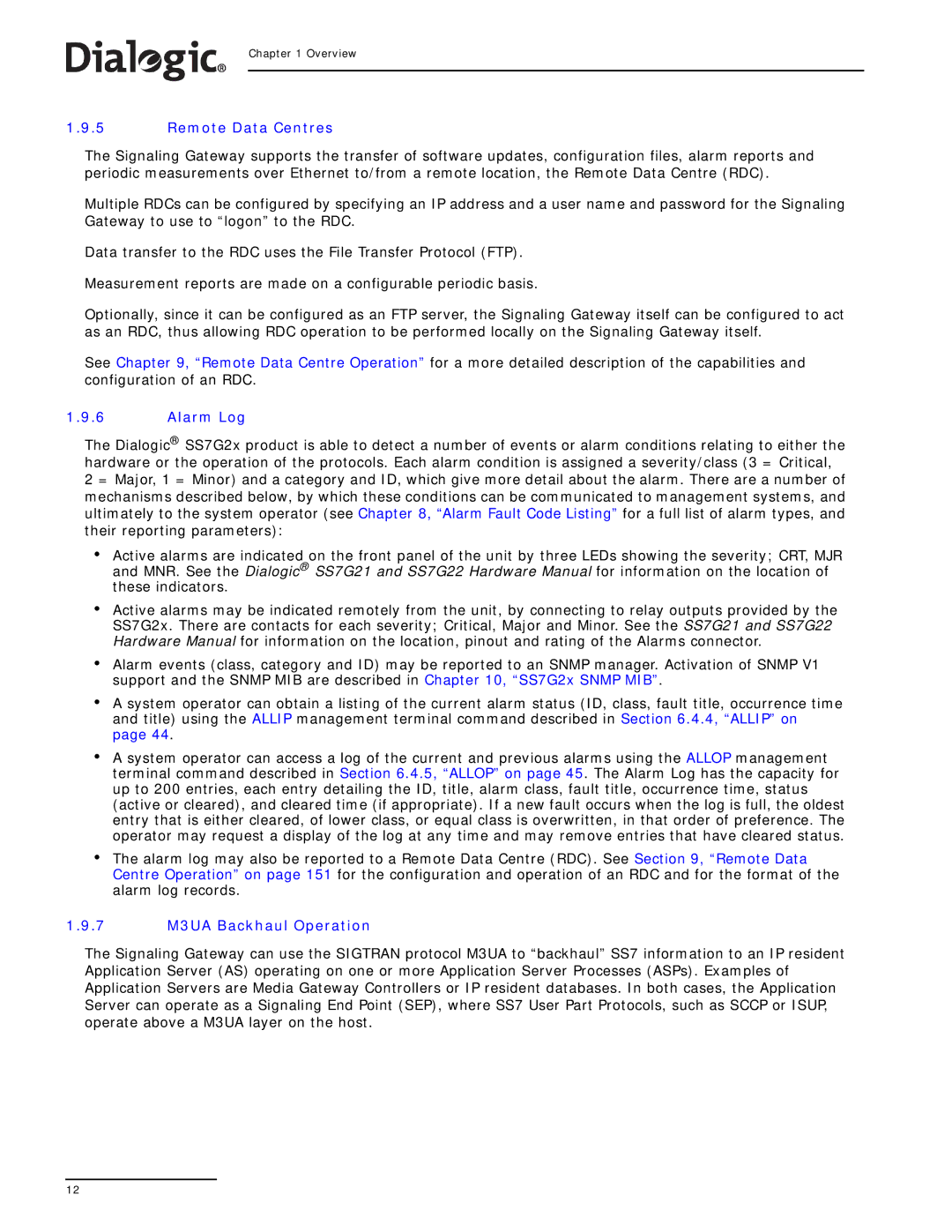
Chapter 1 Overview
1.9.5Remote Data Centres
The Signaling Gateway supports the transfer of software updates, configuration files, alarm reports and periodic measurements over Ethernet to/from a remote location, the Remote Data Centre (RDC).
Multiple RDCs can be configured by specifying an IP address and a user name and password for the Signaling Gateway to use to “logon” to the RDC.
Data transfer to the RDC uses the File Transfer Protocol (FTP).
Measurement reports are made on a configurable periodic basis.
Optionally, since it can be configured as an FTP server, the Signaling Gateway itself can be configured to act as an RDC, thus allowing RDC operation to be performed locally on the Signaling Gateway itself.
See Chapter 9, “Remote Data Centre Operation” for a more detailed description of the capabilities and configuration of an RDC.
1.9.6Alarm Log
The Dialogic® SS7G2x product is able to detect a number of events or alarm conditions relating to either the hardware or the operation of the protocols. Each alarm condition is assigned a severity/class (3 = Critical,
2 = Major, 1 = Minor) and a category and ID, which give more detail about the alarm. There are a number of mechanisms described below, by which these conditions can be communicated to management systems, and ultimately to the system operator (see Chapter 8, “Alarm Fault Code Listing” for a full list of alarm types, and their reporting parameters):
•Active alarms are indicated on the front panel of the unit by three LEDs showing the severity; CRT, MJR and MNR. See the Dialogic® SS7G21 and SS7G22 Hardware Manual for information on the location of these indicators.
•Active alarms may be indicated remotely from the unit, by connecting to relay outputs provided by the SS7G2x. There are contacts for each severity; Critical, Major and Minor. See the SS7G21 and SS7G22 Hardware Manual for information on the location, pinout and rating of the Alarms connector.
•Alarm events (class, category and ID) may be reported to an SNMP manager. Activation of SNMP V1 support and the SNMP MIB are described in Chapter 10, “SS7G2x SNMP MIB”.
•A system operator can obtain a listing of the current alarm status (ID, class, fault title, occurrence time and title) using the ALLIP management terminal command described in Section 6.4.4, “ALLIP” on page 44.
•A system operator can access a log of the current and previous alarms using the ALLOP management terminal command described in Section 6.4.5, “ALLOP” on page 45. The Alarm Log has the capacity for up to 200 entries, each entry detailing the ID, title, alarm class, fault title, occurrence time, status (active or cleared), and cleared time (if appropriate). If a new fault occurs when the log is full, the oldest entry that is either cleared, of lower class, or equal class is overwritten, in that order of preference. The operator may request a display of the log at any time and may remove entries that have cleared status.
•The alarm log may also be reported to a Remote Data Centre (RDC). See Section 9, “Remote Data Centre Operation” on page 151 for the configuration and operation of an RDC and for the format of the alarm log records.
1.9.7M3UA Backhaul Operation
The Signaling Gateway can use the SIGTRAN protocol M3UA to “backhaul” SS7 information to an IP resident Application Server (AS) operating on one or more Application Server Processes (ASPs). Examples of Application Servers are Media Gateway Controllers or IP resident databases. In both cases, the Application Server can operate as a Signaling End Point (SEP), where SS7 User Part Protocols, such as SCCP or ISUP, operate above a M3UA layer on the host.
12
